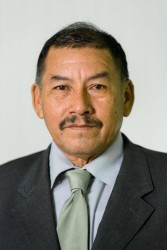Students residing in Guyana’s rural areas have a lower attendance rate than those in other regions, according to the findings of an Out-of-School Children Survey (OOSC) that was conducted by the Ministry of Education, in collaboration with the United Nations Children Fund (UNICEF).
A press statement issued by the Ministry of Indi-genous Peoples’ Affairs said the findings were shared on Monday during a one-day seminar conducted at the National Centre for Educational Resource Development (NCERD) by a national consultant and representative of UNICEF in the presence of Minister of Indigenous Peoples’ Affairs Sydney Allicock, Minister of Education Dr Rupert Roopnaraine, social workers, teachers, regional representatives and other key stakeholders.
The statement said the OOSC initiative is geared at analysing information gathered and scrutinising factors that lead to exclusion from schooling and the existing policies that can significantly reduce the national out-of-school rate.
Leading the survey in terms of achieving a satisfactorily attendance rate was Region Nine, with a record of 74.8 per cent, followed by regions Five, One, Seven, Eight, Three, Ten, Four, Six and Two, with rates that fall between 64.3 per cent and 37.6 per cent.

The findings identified schools in regions One, Seven and Eight as being at a greater disadvantage than compared to schools in the other regions, while also showing that girls have a higher attendance percentage than boys due the fact that they remain in school much longer.
“A parent taking a decision to wait until the child is older to start school and the distance the child has to travel to get to and from school and the conditions in poor families significantly contributed to the children leaving the school system,” the statement said.
Meanwhile, UNICEF’s representative Dr Ingrid Sanchez, in presenting an overview of the project, said “the most important thing of this initiative is this is not only data-driven, but that data is then linked to very careful policy analysis to better understanding what are the barriers that are keeping some of the children out of the school and how governments and societies can support them so they can exercise their right to education.”
National Consultant Clement Henry also pointed out that “regions Two, Three, Four and Ten stood out with above national average OOSC prevalence. There is also a higher OOSC rate among boys as well as higher rates among Amerindians living in riverain and remote communities as well as regions involved in farming, forestry and mining having higher OOSC rates,” the statement noted.
Roopnaraine, in embracing the initiative, noted that “the number of children dropping out of school at both primary and secondary schools has been a great concern for this administration” before pointing out that it is a problem the Ministry of Education has been grappling with for many years. “…Over 90 per cent at the primary and 90 per cent at the secondary level, but unfortunately a significant number of these children will drop out before completing the cycle,” he said.
Meanwhile, Allicock said the nation must be cognisant that the development and nurturing of the nation’s young minds is critical.
Speaking directly to initiatives that positively impact youth 14 years and older, Allicock highlighted the Bina Hill Institute, which he said is geared towards providing youth in the hinterland with an opportunity for higher education.
“We started a secondary school in 2003 with 43 students and to date we have close to 600 students… the idea is to have it properly furnished because theory and practice must go together… So, if we create this incubator for young leaders, they will automatically be drawn to it,” he posited.





